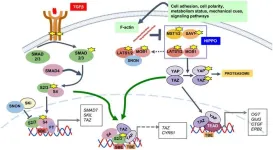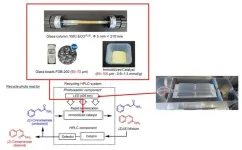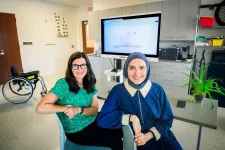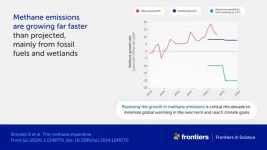(Press-News.org) By Benjamin Boettner
(BOSTON) — Since the 1950s, researchers have used a famous method invented by Wallace Coulter known as “flow cytometry” to characterize different types of immune cells in research studies and in blood samples from human individuals. This has enabled a much deeper understanding of immune cell development as well as new ways to assess human health and diagnose various blood cancers. Later, flow cytometry was applied also to other cell types.
In traditional flow cytometry, cell surface and intracellular proteins are detected with antibody molecules that are linked to fluorescent probes. However, while providing single-cell sensitivity, this method is limited in detecting multiple proteins by the number of fluorophores that can be clearly distinguished within the entire spectrum of fluorescent light. The advent of “mass cytometry” in 2009 allowed the simultaneous quantification of 50 proteins in single cells, and a more fine-grained analysis of cells’ identities and physiological states. In mass cytometry, antibodies are linked to non-radioactive isotopes of metal elements. These isotopes can be quantified in different channels of a mass cytometer instrument based on their mass. However, mass cytometry, and its cousin “image mass cytometry” (IMC), which is used to visualize cell proteins in intact tissue slices, came at the cost of reduced sensitivity compared to flow cytometry and fluorescence microscopy.
Now, another 15 years later, a research collaboration led by the Wyss Institute at Harvard University and also including researchers from MIT and the University of Toronto has developed a method to significantly enhance the sensitivity of mass cytometry and IMC using DNA nanotechnology. Applying a new signal amplification technology called “Amplification by Cyclic Extension” (ACE) to DNA barcodes linked to antibodies, they were able to amplify protein signals produced by antibody-bound metal isotopes more than 500-fold, and to simultaneously and with high sensitivity detect more than 30 different proteins. The new method enabled them to quantitively detect rare proteins, investigate complex biological tissue changes, and study how entire networks of interconnected proteins that regulate immune cell functions respond to stimulation and pathological conditions. Applied to IMC, ACE also allowed the identification of cell types and tissue compartments in histological sections, and changes in tissue organization related to the pathology of polycystic kidney disease. The findings are reported in Nature Biotechnology.
“ACE helps to close a crucial gap in cytometric analysis: by enhancing the sensitivity of mass cytometry, it enables a single cell analysis platform that simultaneously achieves high sensitivity, high multiplexing, and high throughput. The opportunities it opens for investigating single cells in suspension and intact tissues with highly multiplexed and sensitive approaches can provide a much deeper understanding of normal and pathological biological processes,” said Wyss Institute Core Faculty member Peng Yin, Ph.D., who led the study. Yin is also a Professor at Harvard Medical School (HMS)’s Department of Systems Biology.
More DNA, more metal isotopes, more sensitivity
Previously, Yin and his group at the Wyss Institute have developed multiple DNA-powered imaging technologies that can reveal the inner workings of cells with ultra-high resolution at the single molecule level, or by visualizing many distinct RNA and protein molecules in a single tissue slice. But the DNA structures that are created using these methods are not resilient enough to withstand the relatively harsh conditions used in mass cytometry.
“ACE solves current sensitivity problems of mass cytometry by allowing researchers to associate antibody molecules with substantially increased numbers of metal isotopes compared to conventional mass cytometry. This significantly facilitates the quantification of a broad range of low-abundance proteins, which has been challenging using previous single-cell approaches,” said co-first author Xiao-Kang Lun, Ph.D., who is a Postdoctoral Fellow in Yin’s group. Lun collaborated on the project with co-first author Kuanwei Sheng, Ph.D., who had initially developed ACE for other applications, including multiplexed imaging, and is also a Postdoctoral Fellow working with Yin. “Inspired by our previous work on the Primer Extention Reaction for creating linear DNA concatamers (multiple copies of the same DNA sequence linked in series), and the PCR reaction which achieves amplification through synchronized thermal cycles, we invented ACE to synthesize linear concatamers in situ through thermal cycling in a controllable fashion,” said Sheng.
ACE creates a scaffold with multiple binding sites for short metal isotope-carrying “detector strands.” In addition, by branching the synthesis of the scaffold strand, the researchers could further increase the method’s sensitivity for the detection of rare proteins. Linear ACE on average provides a 13-fold signal amplification while branching ACE allows an initially unamplified signal to be increased more than 500-fold. To stabilize the entire ACE sequence complex and keep it intact during mass cytometry analysis, they crosslinked the short double strands formed between the scaffold and the added detector strands with a chemical crosslinker. “Following this recipe, we designed a panel with 33 distinguishable (orthologous) ACE sequences whose synthesis doesn’t interfere with one another, and applied it to three entirely different types of analysis,” said Sheng, who also is a Postdoctoral Fellow on Yin’s team.
An ACE at work
The team first used ACE to investigate the transitions of epithelial cells into mesenchymal cells and back into epithelial cells again. Epithelial-mesenchymal transitions (EMTs) and mesenchymal-epithelial transitions (METs) occur during embryonic development but the former in particular is also re-enacted when tumors become invasive and metastatic. By profiling in total 32 epithelial and mesenchymal markers, signaling molecules, and rare transcription factors in single mouse breast cancer cells multiple times during their 28-day transition from an epithelial to a mesenchymal state and back, and computationally parsing the results, they were able to shed new light on the two processes. “ACE allowed us to profile levels of low-abundance transcription factors simultaneously with markers reflecting cellular physiological and signaling states in single cells. This led to a more refined picture of how molecular programs in EMT and MET are driven by increasing and decreasing amounts of key transcription factors, including Zeb-1 and Snail/Slug,” said Sheng.
In their second example, they zoomed into the inner workings of single T cells. The stimulation of T-cell receptor (TCR) molecules on their surface results in the activation of a complex network of intracellular signaling proteins. Analyzing these signaling responses at single-cell resolution has been difficult, also due to T cells’ small size. Individual proteins of this network are activated by phosphate residues that are attached to them by other network proteins generally known as kinases. Many of these activated network proteins go on to phosphorylate other proteins of the network. This ultimately leads to changes in T-cell behavior, for example, toward pathogens or cancer cells. The researchers applied ACE to a panel of 30 antibodies that specifically bound to phosphorylated motifs in TCR-network proteins with functions in stress, inflammation, cell proliferation and other responses. “Using ACE-enhanced mass cytometry analysis, we captured quantitative snapshots of the dynamically changing TCR network in individual primary human T cells. This allowed us to study the single-cell variations in the timing and duration of specific T-cell activation events and to reveal how the network is activated from its ground state by extracellular cues,” said Lun.
The team used the same ACE-enhanced antibody panel to investigate a phenomenon known as “injury-induced T-cell paralysis.” T cells experiencing injury in their environment, such as tissue injuries caused in major surgical procedures, often become immunosuppressive. To start to understand how the TCR network causes this, Yin’s group collaborated with co-author Michael Yaffe, M.D., Ph.D., who is the David H. Koch Professor of Science and Professor of Biology and Biological Engineering at MIT and has a strong interest in how the microenvironment surrounding sites of tissue injury suppresses the immune system. Yaffe provided the team with samples of “postoperative drainage fluid” (POF) that were obtained from patients undergoing surgery. Stimulating T cells with POFs as well as their TCRs enabled the researchers to isolate distinct network changes that cause single T cells to stop dividing and become exhausted.
Finally, they investigated the utility of ACE also for spatial analysis of proteins in tissue sections using IMC by focusing on the human kidney. Kidney tissue is difficult to analyze by fluorescence microscopy because of its strong autofluorescence, and by traditional IMC because it lacks sensitivity. The researchers developed a panel of 20 ACE-enhanced antibodies for various kidney markers and used it to examine sections of the renal cortex derived from a patient with polycystic kidney disease. This approach, in which they collaborated with co-author Hartland Jackson, Ph.D., Professor at the University of Toronto, Canada and expert in multiplexed imaging, allowed them to identify the different cell types and their organization within the kidney’s proximal and distal tubules, collecting ducts, and blood-filtering glomeruli. “We discovered new disease-specific features of cell and tissue organization and found that the stem cell marker Nestin, which is also associated with kidney disorders, was expressed very heterogeneously across glomeruli,” said Lun. “This could mean that different parts of the tissue could be simultaneously going through different pathological stages.”
"This new mass cytometry approach developed by Peng Yin's team and their collaborators once again shows the power of leveraging DNA nanotechnology to turbocharge an existing technique that is highly relevant for clinical care, and to bring it to a much higher level of sensitivity and specificity. This relatively simple method will lead to entirely new insights into cell, tissue, and organ function, both during health and disease," said co-senior author and Wyss Founding Director Donald Ingber, M.D., Ph.D., whose group provided critical expertise on stimulating T cells. He is also the Judah Folkman Professor of Vascular Biology at HMS and Boston Children’s Hospital, and the Hansjörg Wyss Professor of Bioinspired Engineering at the Harvard John A. Paulson School of Engineering and Applied Sciences.
Other authors on the study are Xueyang Yu, Ching Yeung Lam, Gokul Gowri, Matthew Serrata, Yunhao Zhai, Hanquan Su, Jingyi Luan, and Youngeun Kim. The study was supported by grants from the National Institutes of Health (award # ES028374, CA226898, UG3HL145600, UH3CA255133, DP1GM133052, R01GM124401, RF1MH124606 and RF1MH128861), and the Ontario Institute for Cancer Research.
PRESS CONTACT
Wyss Institute for Biologically Inspired Engineering at Harvard University
Benjamin Boettner, benjamin.boettner@wyss.harvard.edu
###
The Wyss Institute for Biologically Inspired Engineering at Harvard University (www.wyss.harvard.edu) is a research and development engine for disruptive innovation powered by biologically-inspired engineering with visionary people at its heart. Our mission is to transform healthcare and the environment by developing ground-breaking technologies that emulate the way Nature builds and accelerate their translation into commercial products through formation of startups and corporate partnerships to bring about positive near-term impact in the world. We accomplish this by breaking down the traditional silos of academia and barriers with industry, enabling our world-leading faculty to collaborate creatively across our focus areas of diagnostics, therapeutics, medtech, and sustainability. Our consortium partners encompass the leading academic institutions and hospitals in the Boston area and throughout the world, including Harvard’s Schools of Medicine, Engineering, Arts & Sciences and Design, Beth Israel Deaconess Medical Center, Brigham and Women’s Hospital, Boston Children’s Hospital, Dana–Farber Cancer Institute, Massachusetts General Hospital, the University of Massachusetts Medical School, Spaulding Rehabilitation Hospital, Boston University, Tufts University, Charité – Universitätsmedizin Berlin, University of Zürich, and Massachusetts Institute of Technology.
END
ACE-ing protein detection in single cells
ACE, a new DNA-powered signal amplification technology, dramatically increases sensitivity of mass cytometry, opening new windows on many biological and pathological processes
2024-07-30
ELSE PRESS RELEASES FROM THIS DATE:
Study finds police misconduct ‘hotspots’ across Florida
2024-07-30
Not all police misconduct is the same. Misconduct can range from offenses like homicide and sexual assault to seemingly minor infractions such as accepting free coffee from the public. Exactly what qualifies as police misconduct varies locally, and the response to this behavior is typically handled internally by law enforcement.
The absence of a commonly accepted framework to assess and interpret police misconduct remains a complex and contentious issue. Moreover, progress in researching this area is hindered by the limited ...
Engineered microbes repel mosquitoes
2024-07-30
Genetically engineered human skin bacteria can make mice less attractive to mosquitoes for 11 days. Mosquitoes transmit a host of deadly diseases, including malaria, West Nile, dengue, yellow fever, and Zika. Female mosquitoes on the hunt for a blood meal tune into scents released by skin microbes that live on their targets. Omar Akbari and colleagues engineered versions of the common human skin commensals Staphylococcus epidermidis and Corynebacterium amycolatum to produce much less of a form of lactic acid known to attract mosquitoes. The authors tested the microbes alone and found the engineered version of S. epidermidis attracted about half as ...
TGF-β and HIPPO signaling pathways interplay in distinct hepatic contexts
2024-07-30
The liver's ability to communicate with other organs is crucial for maintaining homeostasis, particularly through signaling pathways. During liver regeneration, communication with organs such as the brain, pancreas, intestine, and heart is vital, mediated by chemical messengers like hormones, cytokines, and growth factors. Among these signals, the TGF-β and HIPPO pathways are critical, functioning as tumor suppressors and regulating liver development and regeneration. The review focuses on these pathways' interplay in maintaining liver homeostasis, facilitating regeneration, and contributing to diseases like hepatitis, fibrosis, ...
Bacteria and keloids
2024-07-30
A study explores the microbiome of keloids, which are treatment-resistant raised scars. Some wounds heal completely; some wounds leave a scar; and some wounds leave a noticeable raised and growing bump larger than the original wound called a keloid. These keloids can itch and cause psychological distress. Keloids are caused by hyperproliferation of cells called fibroblasts that produce collagen. Previous research had suggested that microbiota might be one of many factors influencing fibroblast production. Rui Chen, Tomasz Maj and colleagues looked for bacteria in clinical samples of keloid tissue and found higher concentrations ...
Diet and supplements in cancer prevention
2024-07-30
Cancer is a complex, multifactorial disease with a substantial global burden. Recent years have seen a surge in research focusing on preventive measures, particularly through diet and supplements. The role of nutrition in cancer incidence and prevention is widely recognized, though the specifics of these relationships remain under investigation. This review expands on the findings of Anandu Chandra Khanashyam et al., exploring the nuanced links between diet, supplements, and cancer prevention.
The significance of diet and supplements in cancer prevention is well-documented, with nutrition ...
Breakthrough in Z-alkene synthesis: Scientists develop efficient and sustainable method
2024-07-30
Z-alkenes are organic compounds with a double bond between two carbon atoms and two substituents attached to the carbon atoms on the same side of the double bond. They are ubiquitous structural components of organic compounds in chemistry and biology. It is well known that many of the Z-alkenes cannot be prepared through conventional methods involving thermodynamic methods while photoisomerization can offer good yields. Photoisomerization is a process in which the structural arrangement of an isomer of a molecule is changed to another isomer by absorption of light. The photoisomerization of E-alkenes to produce Z-alkenes ...
Study: Fear of falling, fall-related injuries haunt full-time wheelchair, motorized scooter users
2024-07-30
CHAMPAIGN, Ill. — Many studies have focused on falls among people who are ambulatory and have conditions like multiple sclerosis or Parkinson’s disease, but research to address falls among those who rely on wheelchairs or motorized scooters is rare, scientists report in a new study. The researchers found that full-time wheelchair or motorized-scooter users also experience falls and fall-related injuries, and many live with the fear of falling again.
The findings are detailed in the journal Disability and Rehabilitation.
According to the U.S. Census Bureau, 5.5 million Americans ...
Oil and gas extraction causes pollution to spike 10,000%
2024-07-30
North Sea oil and gas extraction can cause pollution to spike by more than 10,000% within half a kilometre around off-shore sites, a study has found for the first time.
The University of Essex, Natural History Museum and Centre for Environment, Fisheries and Aquaculture Science (CEFAS) research has uncovered the true impact on Britain’s seabed life - with the number of species plummeting nearly 30% near platforms.
The findings, published in Science of The Total Environment, come in the face of continued global fossil fuel exploration.
The study discovered pollutants like hydrocarbons were up to 10,613% higher within 500m ...
Using the term ‘artificial intelligence’ in product descriptions reduces purchase intentions
2024-07-30
PULLMAN, Wash. – Companies may unintentionally hurt their sales by including the words “artificial intelligence” when describing their offerings that use the technology, according to a study led by Washington State University researchers.
In the study, published in the Journal of Hospitality Marketing & Management, researchers conducted experimental surveys with more than 1,000 adults in the U.S. to evaluate the relationship between AI disclosure and consumer behavior.
The findings consistently showed products described as using artificial intelligence were less popular, according to Mesut Cicek, clinical assistant professor of marketing and lead author ...
Three-step plan to cut overlooked methane emissions could help us stop global warming faster
2024-07-30
To control the climate crisis, we must tackle methane emissions now. Methane has contributed about half the global warming we’ve experienced so far, and emissions are climbing rapidly. An international team of climate researchers writing in Frontiers in Science set out three imperatives to cut methane emissions and share a new tool to help us find the most cost-effective ways of doing so.
“The world has been rightly focused on carbon dioxide, which is the largest driver of climate change to date,” said Professor ...
LAST 30 PRESS RELEASES:
Post-stroke injection protects the brain in preclinical study
Cardiovascular risk score predicts multiple eye diseases
Health: estimated one in ten British adults used or interested in GLP-1 medications for weight loss
Exercise to treat depression yields similar results to therapy
Whooping cough vaccination for pregnant women strengthens babies’ immune system
Dramatic decline in new cases of orphanhood in Uganda driven by HIV treatment and prevention programs
Stopping weight loss drugs linked to weight regain and reversal of heart health markers
Higher intake of food preservatives linked to increased cancer risk
Mass General Brigham–developed cholera vaccine completes phase 1 trial
First experimental validation of a “150-year-old chemical common sense” direct visualization of the molecular structural changes in the ultrafast anthracene [4+4] photocycloaddition reaction
Lack of support for people on weight loss drugs leaves them vulnerable to nutritional deficiencies, say experts
Dogs’ dinners can have greater climate impact than owners’
Are you ready to swap salmon for sprats and sardines?
1.6 million UK adults used weight loss drugs in past year
American College of Cardiology comments on new dietary guidelines for Americans
American Society of Gene & Cell Therapy and Orphan Therapeutics Accelerator partner to advance and commercialize promising rare disease treatments
One in 14 patients having day case surgery have new or worse chronic pain 3 months after their operation
New study highlights link between eviction rates and gun violence
Heatwaves heat up soil but not toxin levels in rice, study finds
Digital modeling reveals where construction carbon emissions really come from
Turning farm waste into water filters
New study shows how the spleen helps the immune system accept a transplant
New Mayo Clinic study advances personalized prostate cancer education with an EHR-integrated AI agent
Researchers identify novel therapeutic target to improve recovery after nerve injury
Microbes in breast milk help populate infant gut microbiomes
Reprogramming immunity to rewrite the story of Type 1 diabetes
New tool narrows the search for ideal material structures
Artificial saliva containing sugarcane protein helps protect the teeth of patients with head and neck cancer
Understanding the role of linear ubiquitination in T-tubule biogenesis
Researchers identify urban atmosphere as primary reservoir of microplastics
[Press-News.org] ACE-ing protein detection in single cellsACE, a new DNA-powered signal amplification technology, dramatically increases sensitivity of mass cytometry, opening new windows on many biological and pathological processes





